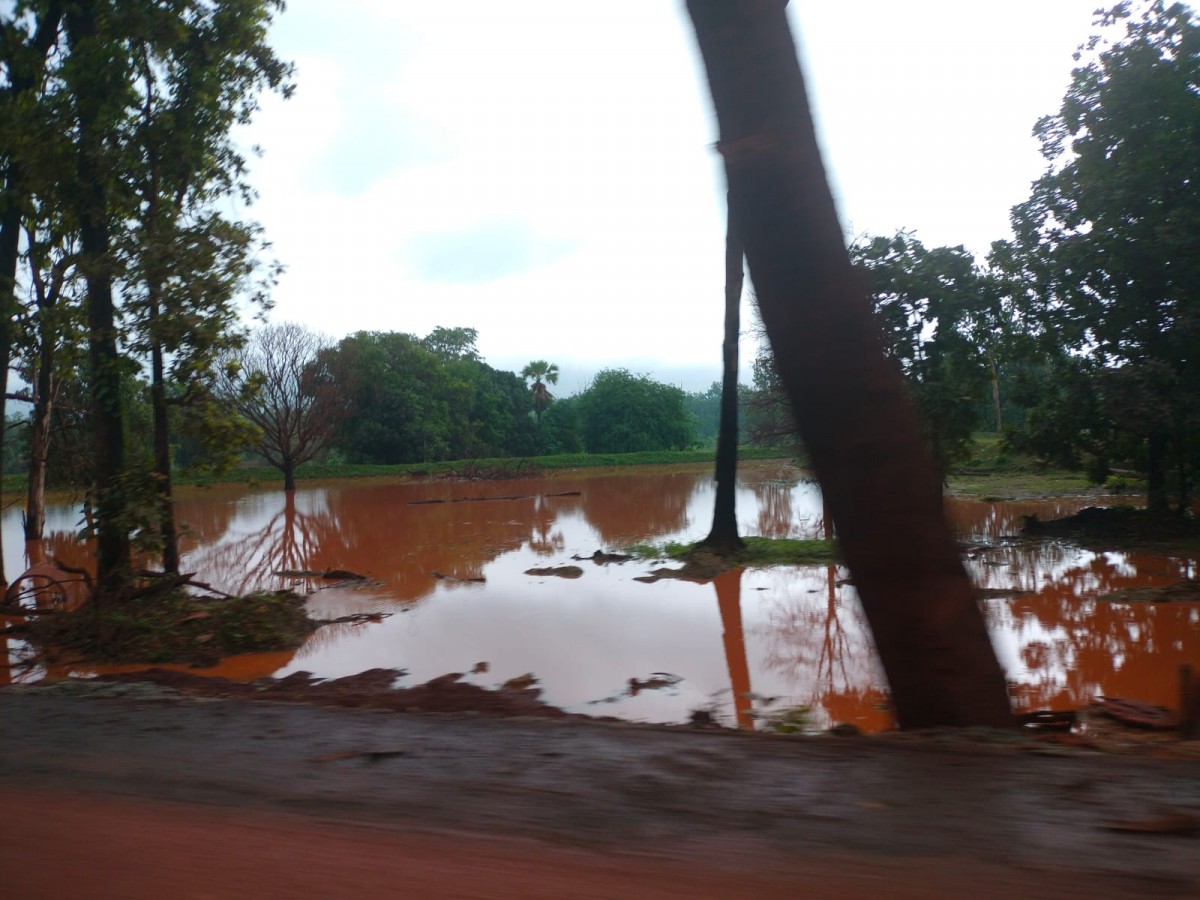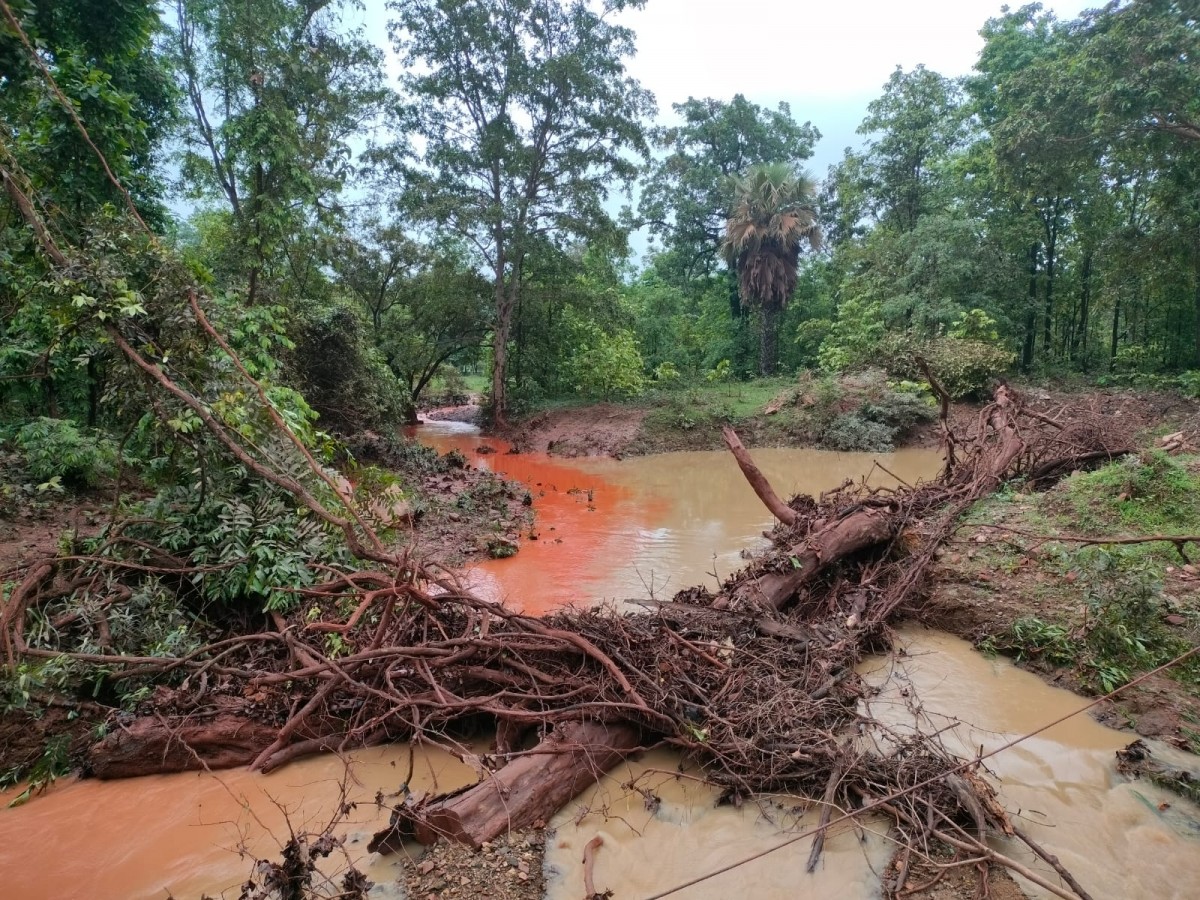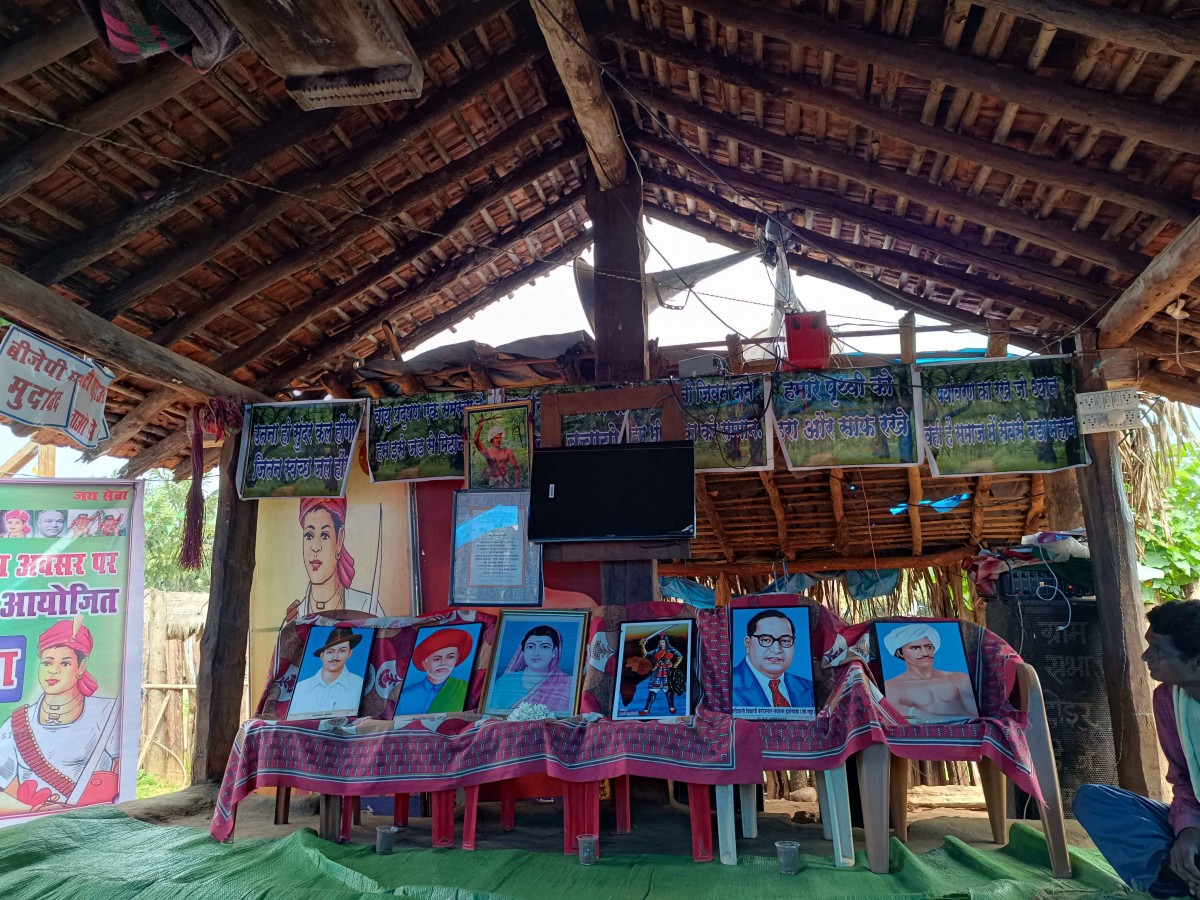'76 Years After Independence, We Still Fight': In Gadchiroli, a 150-Day Protest Against Mining
"During British rule and the fight for independence, great revolutionaries like Savitribai Phule fought for the right to women's education. Moolnivasi revolutionaries like Veer Baburao Shedmake and Birsa Munda died at a young age fighting for jal, jangal and zameen – water, forests and land – without sparing a thought for themselves. We celebrate Independence Day now, but these same issues persist and have gotten worse. We still use the same oppressive British penal laws and more Adivasi, Moolnivasi and Dalit people have died or been imprisoned in land-related conflicts since this so-called independence. What we have today is thus a false independence."
These are the words of Mangesh Narote of Besewada village of Gadchiroli district in Maharashtra.
In the same district, a protest at Todgatta, against iron mining in Damkondawahi and Surjagarh has been afoot for the past 150 days.
It is led by the Madia-Gond Adivasi community. Representatives from over 70 villages have been taking turns to occupy a stretch of land in Todgatta. The Damkondawadi Bachao Andolan thus ensures that its participants can earn a livelihood while keeping up the protest against multiple new and expanding mining projects in the region.
Back in 2005, 25 mining projects were proposed in Gadchiroli district. Out of these, Lloyd's Metals and Energy Private Limited, in Surjagarh, has been operating an iron mine on and off since 2007. It was granted environmental clearance in 2022 – through what protesters say was a rigged public consultation – to expand its capacity from 3 million tonnes per annum or MTPA to 10 MTPA, and start a crushing and processing plant in Aidri, Malampadi and Bande villages. This mine encroaches upon the land already granted to people from surrounding Adivasi villages as part of their community forest rights land under the Forest Rights Act, 2006. According to protesters from Todgatta, Lloyd's also conducted a public hearing two months ago for a steel processing plant in Konsari of Gadchiroli district.
Recently, six new mines spanning 4,684 hectares have been proposed and leased through a composite mining lease to five companies: Omsairam Steels and Alloys Private Limited, JSW Steels Limited, Sunflag Iron and Steel Company Limited, Universal Industrial Equipment and Technical Services Private Limited, and Natural Resources Energy Private Limited.
In 2021, the construction of a four-lane highway was started but rapidly shut due to strong community opposition.
It is important to note that although the land for the new mines falls within traditional boundaries of forest use and occupation, the government has not recognised these traditional boundaries in the community forest rights (CFR) that have been granted to the nearby 13 and more Adivasi villages.
The government granted suo motu CFR in 2015 to villages on both sides of the mountain, but it only granted half of the traditionally occupied land and did not include any land from the mountain in the CFR.
This has left the entire mountain range vulnerable to mining and has also limited surrounding communities' legal claim on the mountain.
Exploitation of land and livelihood
Since the Lloyd's mine came up in Surjagarh, agriculture, health and other aspects of life in the region have severely suffered due to red iron oxide discharge, chemical effluents, and large amount of debris. The fresh water in the region has turned red and is unusable.

Red water in Surjagarh. Photo: By arrangement
In 2022, an Adivasi man, Ajay Topo, died by suicide in Malampadi village. Topo had been worried because debris had overrun his agricultural field in the monsoon.
Other forest-based livelihoods like those of tendu leaf collectors have been severely impacted since the very beginning of mining operations.
Locals said that all food and medicines for illnesses like stomach aches, fever, headaches, snake and scorpion bites, etc., along with the timber and bamboo needed for building houses came from the forest earlier. There was also plenty of fresh water. "Our material needs were completely met by the forest and we rarely purchased anything. Our sacred deities were also in the mountain and we used to spend a lot of time there. Now the company, and its police, do not let us enter our own lands," a local said. This was a common account in the region.
Also read: In Gadchiroli, the Mining of Another Adivasi God
In terms of health, according to a study published in 2016 in the International Journal of Current Multidisciplinary Studies, mining of iron ore causes irreversible damage to underground water systems and surface water, thereby severely affecting the health of those using the water. "The average lethal dose of iron is 200-250 mg per kg of body weight, but death has occurred following the ingestion of doses as low as 40 mg per kg of body weight," the study said.
People have been known to suffer from various diseases such as catharsis, dehydration and gastro-intestinal irritation. Iron ore can interfere with normal body fluid regulation even long after a mine has been closed.

Fresh water in Surjagarh. Photo: By arrangement.
Criminalisation
"Here, everything takes place in a collective manner," says advocate Lalsu Nogoti, referring not only to the protest set-up at Todgatta, but also to everyday life, for both of which villagers convene at the Gotul or village square.
The Gotul is a constant yet fluid space that simultaneously functions as a university, a court, an entertainment centre, an information hub, and a community centre. One does not sit still in a Gotul – adults and elders engage in basket-weaving, rope-making, and even plowing while the children and youth learn from watching. There is no admission required, and no graduation date, for this practical and generationally-transferred education. The Gotul also acts as a court, addressing community issues in a democratic way. Importantly, the Gotul acts as the space wherein people share stories and wisdom, news about national and international issues, and currently, carry out their democratic protest, along with discussions and decisions on it.
Suresh Lule Mattami, a member of the Adivasi Yuva Chhatra Sangathan, says, "In our traditional gram sabha we have a space to speak freely. We all discuss the next steps of the protest together, and help each other learn and understand what to do. If someone is unhappy with a decision, we try to listen, understand and come to a common consensus using our traditional processes of decision-making."
Every morning, village representatives – each one representing 10 people back home and who attend in rotational shifts of a few days each – at assemble at the Todgatta Gotul and start their meeting by paying their respects to Birsa Munda, Rani Durgavati, Savitribai Phule, Jotiba Phule, Dr. B.R. Ambedkar and Bhagat Singh.

The protest at Todgatta in Maharashtra's Gadchiroli. Photo: By arrangement.
They read the preamble of the constitution translated into Madia, and then take attendance while collectively discussing challenges and important developments in the protest. Mangesh Narote, quoted at the very beginning of this piece, says, "The very existence of this protest village [Todgatta] reiterates the reason for our protest. This sort of sustenance would simply not be possible in the city. It would be hot, our tarp would fly away, and we would have no way to feed or sustain ourselves. We are able to meet our collective protest needs only because we are in the forest. How can anyone survive without jal-jangal-zameen?"
However, this democratic and peaceful protest has been repeatedly criminalised by the state-corporate nexus.
Locals ask how the model of 'sabka saath, sabka vikaas (the Modi government's motto, translating to 'with all, development for all')' serves them.
Rakesh Alam, president of the Adivasi Yuva Chhatra Sangathan, and Pattu Pottami, Gram Sabha Adhyaksh of Dodur are united in their takedown of the way locals' rights have been trampled upon to make way for corporates. "The first thing they did to start the mining process in Damkondwahi was to build a road and establish Jio signal towers. Then they built police stations. We are not against roads or connectivity, but we know that these are for the company officials, not for us. Similarly, we know that the police stations are not for our safety, but rather, they have been built to repress our mass dissent," Alam and Pottami say.
Ganesh Korsa, member of the Adivasi Yuva Chhatra Sangathan, also expresses his concern at the growing number of police camps, saying, "If they completely take over our mountain and put up police camps, we will not even be able to move freely between out own houses and villages."
Also read: Gadchiroli Ground Zero: The Adivasi Struggle Against 'Development' That Displaces
Protesters in Todgatta say the mine has also led to an increase in violence against women. They stress that allegation of violence does not just mean physical violence from the police, but also encompasses the mental hardships of becoming a widow, dealing with alcohol addiction and violence within the home, ensuring a safe space for their children, and many other such experiences that cannot be articulated. A Nari Mukti Samiti is currently being formed, the process of which is being led by Sushila Narote.
The villagers point out how the takeover was rushed and kept them out. On October 27, 2022, the public consultation for the Lloyd's mine's expansion and crushing plant took place at Gadchiroli city. Just before the consultation, buses full of people who had allegedly been bribed by the company, arrived. Such people, who villagers say had turned up intoxicated, took over the venue. The police prevented movement leaders from entering the consultation area. Thus none of the gram sabhas in Surjagarh Patti – the area which would actually face the impact – were consulted.
Activists are quickly labelled "Maoists" or "anti-national."

Surjagarh. Photo: By arrangement.
Several activists – including Nitin Padda, Ramdas Gera, Sainu Gotu, Shiela Gota, Pattu Pottami, Jai Sri Virda, Sushila Narote, Rakesh Alam, and Mangesh Narote amongst many others – have been charged under Section 110 (punishment of abetment if person abetted does act with different intention from that of abettor.) and 353 (assault or criminal force to deter public servant from discharge of his duty) of the Indian Penal Code.
The protesters say they have faced police beatings and have been implicated in false cases. Some say they were brutally lathi charged and locked away without any clear accusations levelled. While the death of three mine workers on August 6 was fortunately captured by the media, the deaths of other mine workers from nearby and migrant communities never come under the spotlight.
According to the 2021 National Crime Records Bureau (NCRB) data on prisons, seven in 10 of the 5,54,034 people in prison in Indian jails are under trial and a majority are from marginalised castes (21.21% SCs, 10.78% STs, 35.83% OBC).
"When we protest democratically, the government should listen to us and treat us equally. But they are obsessed with making the big money bigger, and squashing the small even further. They fail to understand that a person does not become big on their own – they are made up of everyone," Narote stresses.
"In a tree, the roots are sturdy and big and play the role of taking in water. The branches and leaves, although very small, are crucial in that they absorb sunlight and provide nutrition to the tree. Without the leaves, the roots cannot exist," he says.
But the government doesn't recognise this, he adds.
Anjali, Shubha and Gowri are graduates in Sociology and Anthropology. Anjali and Shubha are members of the Yugma Collective, which can be contacted at +917769871242.
This article went live on August fifteenth, two thousand twenty three, at zero minutes past three in the afternoon.The Wire is now on WhatsApp. Follow our channel for sharp analysis and opinions on the latest developments.




